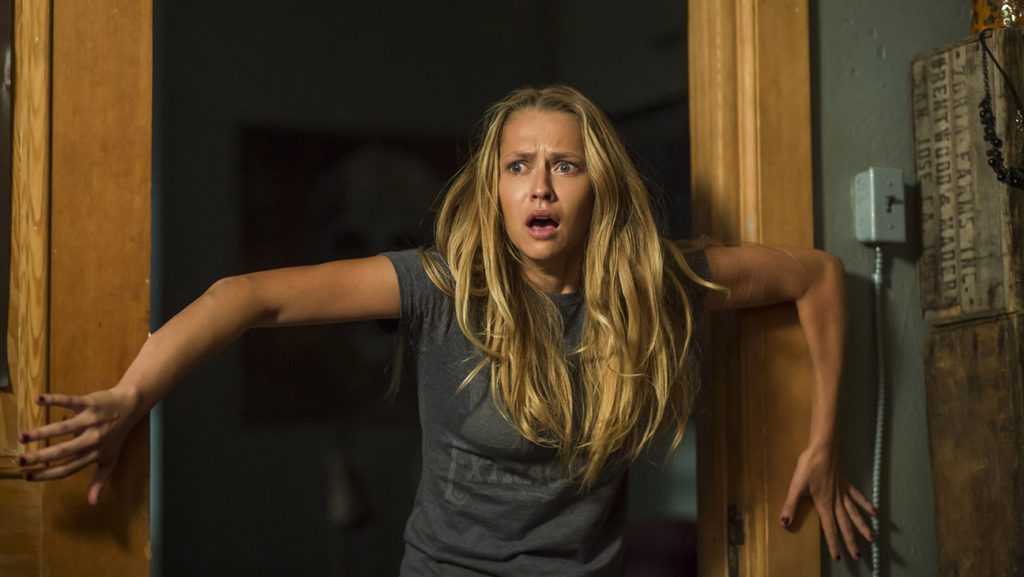
 One
of the most common fears we humans have is a fear of the dark.
Mostly it stems from the innate fear of the unknown, and due to the
fact that it's difficult or impossible to see in the dark, depending
on the levels of darkness, our minds go into overdrive in anticipating
what nastiness might actually lurk in those voids that can't be seen.
One
of the most common fears we humans have is a fear of the dark.
Mostly it stems from the innate fear of the unknown, and due to the
fact that it's difficult or impossible to see in the dark, depending
on the levels of darkness, our minds go into overdrive in anticipating
what nastiness might actually lurk in those voids that can't be seen.
Directed by Swedish first-time feature helmer David F. Sandberg, who
is fleshing out his own three-minute short film from 2013 with a
screen adaptation from Eric Heisserer (Hours,
Final Destination 5),
Lights Out plays with those fears in constructing a story in
which the malevolent force is actually a creature of the dark,
empowered whenever and wherever there is the absence of light, to the
point where those who've seen her have to keep a light source with
them at all times, for fear of madness or worse -- a grisly death.
The main story involves a dysfunctional family, who are particularly
in dire trouble now that the depressed mother, Sophie (Bello,
The 5th Wave), has begun to re-emerge
with signs of mental illness that she thought her medication had all
but completely eradicated. Sophie's first husband has gone
missing under mysterious circumstances, though we get to see that
hubby number two (Burke, Twilight)
is actually brutally murdered by a supernatural force while in
his workplace (there's barely a mention of this event among the family
afterward, curiously). Sophie's daughter, the long-suffering
Rebecca (Palmer, Triple 9), no
longer chooses to visit her now that she has taken a turn for the
worse, leaving Sophie's young son, Martin (Bateman,
Band of Robbers), in a very
vulnerable spot, all alone with a sick mother and an entity that she
is always talking to in the shadows. As Martin reaches out for
help, half-sister Rebecca gets thrust back into the family issues that
have haunted her over the years, having to get to the bottom of the
jealous evil presence in the house that her mother has called "Diana",
who lives and kills in the darkest recesses of the house.
While it has been generally getting favorable reviews from most media
sources, mine won't be counted among them, even though I do think it
is better than most PG-13 rated jump-scare flicks to come out in the
last year, some produced by James Wan (Conjuring
2, Insidious: Chapter 3), who
gets a credit here. One of the reasons is that it establishes a
certain set of rules regarding where and when Diana, who we see in
silhouette form for most of the film, can exist determined purely by
whatever Sandberg dictates from scene to scene. Diana never
seems to leave the house to attack the family members when they are
most vulnerable, and yet she appears at the husband's place of
employment in the prologue to the movie.
This brings up another issue with many horror films in recent years,
which is that the families involved in the hauntings seem to be
trapped within their own little universe. Houses seem free of
history except to re-establish family through pictures and drawings.
External characters only enter to serve a vital purpose. Do any
of these characters have friends who might randomly call or pop by?
Do their neighbors ever hear the perpetual screams from within the
house next door? Why does the entire film feature locales and
characters that only feel like idealized sketches of reality instead
of real life?
As with many other horror films, the story requires complete
obliviousness to obviousness. In the opening scene, the father
is on the phone while a shaken coworker, who Diana has shown herself
to for reasons that aren't known, tries to warn him that there is
someone, or something, in the building. He impatiently tells her
that he needs to continue the call and to basically buzz off, and once
she's gone he spends all of three seconds wrapping up the phone
conversation and hanging up. Couldn't he have told her to wait
just a few seconds?
The product placement is particularly obnoxious in Lights Out,
a film made for Warner Bros. Studios. As such, Warner Brothers'
properties are all over the screen, including the DC Universe,
starting with posters and action figures depicting Superman, Batman,
and the Justice League. Warner Bros. heavy metal act Avenged
Sevenfold also get prominent poster placement in Rebecca's apartment,
though the band has been trying to leave the label in recent months.
I wasn't quite quick enough to see what the band is that appears on
the cellphone screen of a character who uses it as a light source in a
pinch to thwart Diana's advancements, but I would wager a guess that
it's a band also affiliated with Warner Music.
There are some elements that are refreshing. For one, the main
female protagonist isn't an innocent, virginal goodie-goodie, as
Rebecca is a metal-head who doesn't really see the need for a
committed relationship, willing to engage in casual sex without the
necessary promise for more. Her most long-lasting of these
hook-ups is her current boy-toy, Bret (DiPersian, "Single Ladies"),
who is also quite a novelty in horror cinema, as the wanna-be
boyfriend, used primarily for light comic relief. Bret values more
than just sex, wanting to pursue something real, even trying to get
his "foot in the door" by leaving one sole sock in Rebecca's clothes
bureau (it is promptly rejected).
At 81 minutes, the film, at the very least, doesn't stay beyond what's
necessary, even for those who aren't swept up in its standard horror
movie developments. The lighting effects are quite cool, and the
film does feature a good cast assembled on a relatively low budget,
and Sandberg shows promise in putting together some tension for his
horror moments, even if the build-up could be much better than what's
delivered. Alas, the thin story elements are a liability, and
merely serve us only the information necessary to deliver standard
booga-booga jump scares that only a complete neophyte won't see
coming. As for anything resembling logic or what real people
might do in their respective situations, it's just not dealt with,
making the entire premise feel solely like a set-up to a superficial
sensory-stimuli experience with a clumsy at a depression metaphor
rather than a means to tell a full story.
As quickly vanishing from the mind as Diana from one's vision once you
emerge from the darkened theater back to the safety of your well-lit
home, you won't likely
be leaving the lights on after this tepid attempt at terror.
Qwipster's rating
:







©2016 Vince Leo

 One
of the most common fears we humans have is a fear of the dark.
Mostly it stems from the innate fear of the unknown, and due to the
fact that it's difficult or impossible to see in the dark, depending
on the levels of darkness, our minds go into overdrive in anticipating
what nastiness might actually lurk in those voids that can't be seen.
One
of the most common fears we humans have is a fear of the dark.
Mostly it stems from the innate fear of the unknown, and due to the
fact that it's difficult or impossible to see in the dark, depending
on the levels of darkness, our minds go into overdrive in anticipating
what nastiness might actually lurk in those voids that can't be seen.